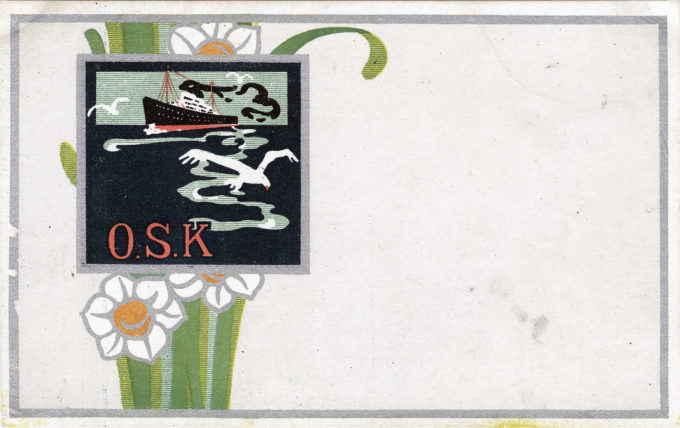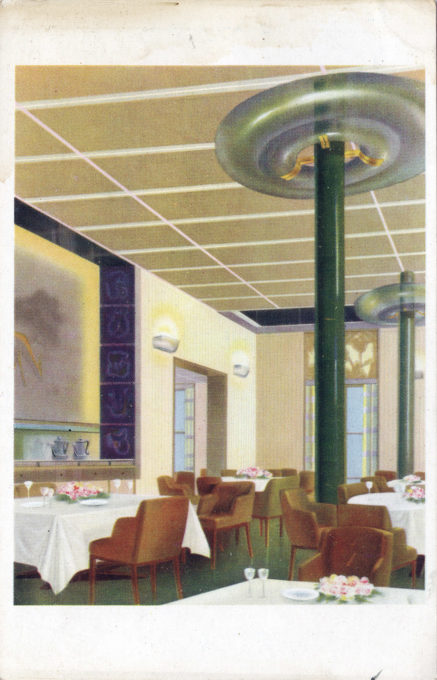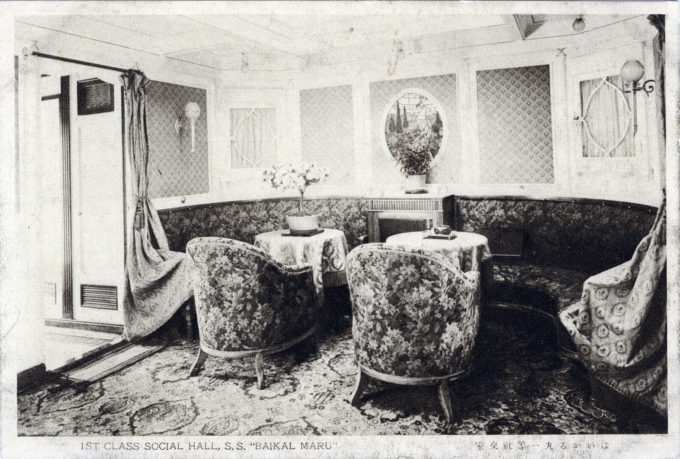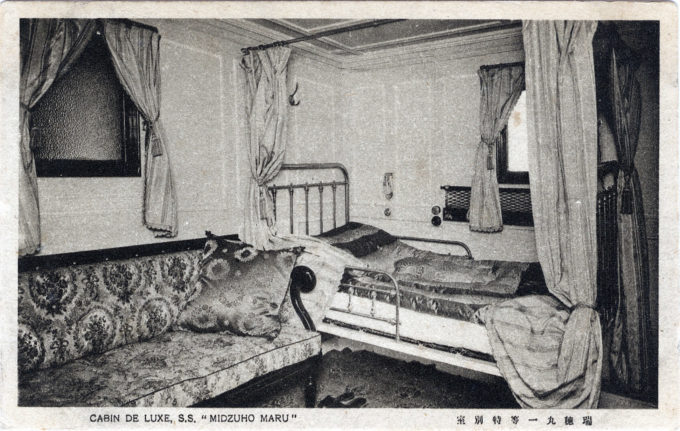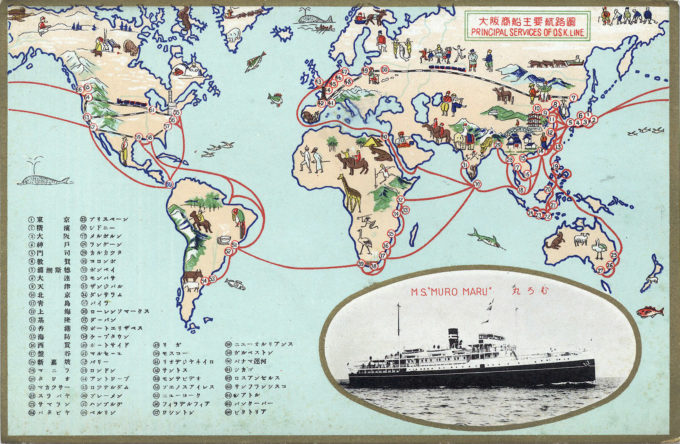
“Principal services of O.S.K. Line”, c. 1930, illustrating the passenger-cargo shipping company’s principal ports-of-call around the world. Pictured is the the M.S. Muro Maru, laid down in June 1926 and built by Mitsubishi Ship Building and Engineering, K. K. as a 1,600-gross ton passenger-cargo ship, launched at Kobe on 9 December 1926, and entering service between Japan and the China coast in February 1927. In 1938, the vessel was requisitioned by the Imperial Japanese Navy for use, first, as a “special transport ship” and, then, as a hospital ship stationed primarily around Rabaul, Truk, Saipan and the Marshall Islands. Muro Maru was inadvertently sunk outside of Manila harbor in November 1944 by US carrier planes.
See also:
M.S. “Oto-maru”, Inland Sea routes, O.S.K. Lines, c. 1930.
M.S. Nachi Maru, c. 1930.
“Honkon (Hongkong) Maru”, T.K.K. Line, 1913.
“Two new steamers built in an English shipyard have been added to the European service of the Osaka Shosen Kaisha.
“Added to the five freighters already in operation on the European run, these new boats, the London Maru and the Paris Maru, will make possible a regular monthly service. Each of the new boats has accommodations for 20 first-class passengers.
“The London Maru, which left Yokohama early in September on her maiden voyage, carried a cargo of silk and fish oil. A return cargo of machinery and chemicals will be accumulated in Germany.
“The other O.S.K. steamers on the O.S.K. line to Europe consist of five freighters which carry a similar type of cargo and call at Kobe, Dairen, Shanghai, Hongkong, Singapore, Colombo, Port Said, Marseilles, London, Hamburg, Antwerp and Rotterdam.”
– The Trans-Pacific, September 1922
“The most striking feature in Japan’s recent development of her mercantile marine is the replacement of her old steam freighters by fast and economical motorships … The most significant of all is the remarkable improvement of its cargo services by the Osaka Shosen Kaisha (O.S.K.).
“This company has decided to place on its New York Line four new Sulzer-engined cargo ships of 8,400 tons each: the Kinai Maru, the Tokai Maru, the Sanyo Maru, and the Hokuroku Maru. These ships are now being built at the Nagasaki yard of the Mitsubishi Shipbuilding and Engineering Co., Ltd., and the first ship of the four, the Kinai Maru, is to enter into active service in July [1930].
“On its Australian Line, the O.S.K. is to place three Burmeister & Wain-engined cargo ships of 5.500 tons each: the Sydney Maru, the Melbourne Maru, and the Brisbane Maru.
“Two more Sulzer Diesel-engined semi-cargo ships of 9.600 tons each, the Buenos Aires Maru and the Rio de Janeiro Maru, are now operating on the O.S.K.’s South American Line.
“All told, the company will operate eleven new motorships on its overseas lines under its own flag in addition to the thousands of new motorship tonnage recently built for its coastwise and China services, including the Ural Maru, a geared turbine engined ship of 6.400 tons, now on the Dairen run, and the Sumire Maru and the Midori Maru, two sister ships of nearly 2,000 tons each, equipped with Mitsubishi-Vickers engines, for its Inland Sea Service.
“… The inauguration of the O.S.K. ‘Express Freight Service’ on its New York Line marks a new development in Japanese shipping enterprise. [The ships] will make more than 18 round trips a year, the drawing cards of the service being safety, punctuality and speed.
“On their outward voyages from Hongkong these liners will call at Keelung, Shanghai, Dairen, Taku, Kobe, Nagoya, Shimizu (during the green tea export season), Yokohama, Los Angeles, Balfour, Chritobal, terminating the voyage at New York. During the period allocated for their stay in New York, they may load or unload cargo at Boston, Baltimore, Norfolk, or elsewhere as the occasion may demand.
“A cut of ten days in one round trip is the feature of O.S.K.’s Australian service by their three new cargo motorships … These liners are designed for the transportation of special cargoes peculiar to this run: wool, silk goods, tallow and livestock such as chicken, sheep and horses. A special device is installed on the after deck for providing the livestock with drinking water.”
– “O.S.K’s New Passenger and Express Cargo Liners”, The Far Eastern Review, June 1930
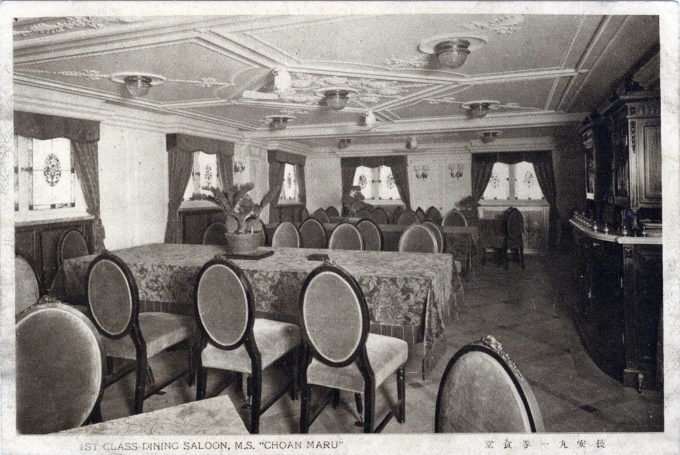
“1st Class Dining Saloon, M.S. Choan Maru“, O.S.K. Lines, c. 1930. The Choan Maru serviced O.S.K.’s Kobe-Tianjin (China) route from 1927 until requisitioned by the Imperial Japanese Navy in November 1941.
- “1st Class Social Hall, M.S. Baikal Maru“, O.S.K. Lines, c. 1930.
- “Cabin de Luxe, M.S. Midzuho Maru“, O.S.K. Lines, c. 1930.


